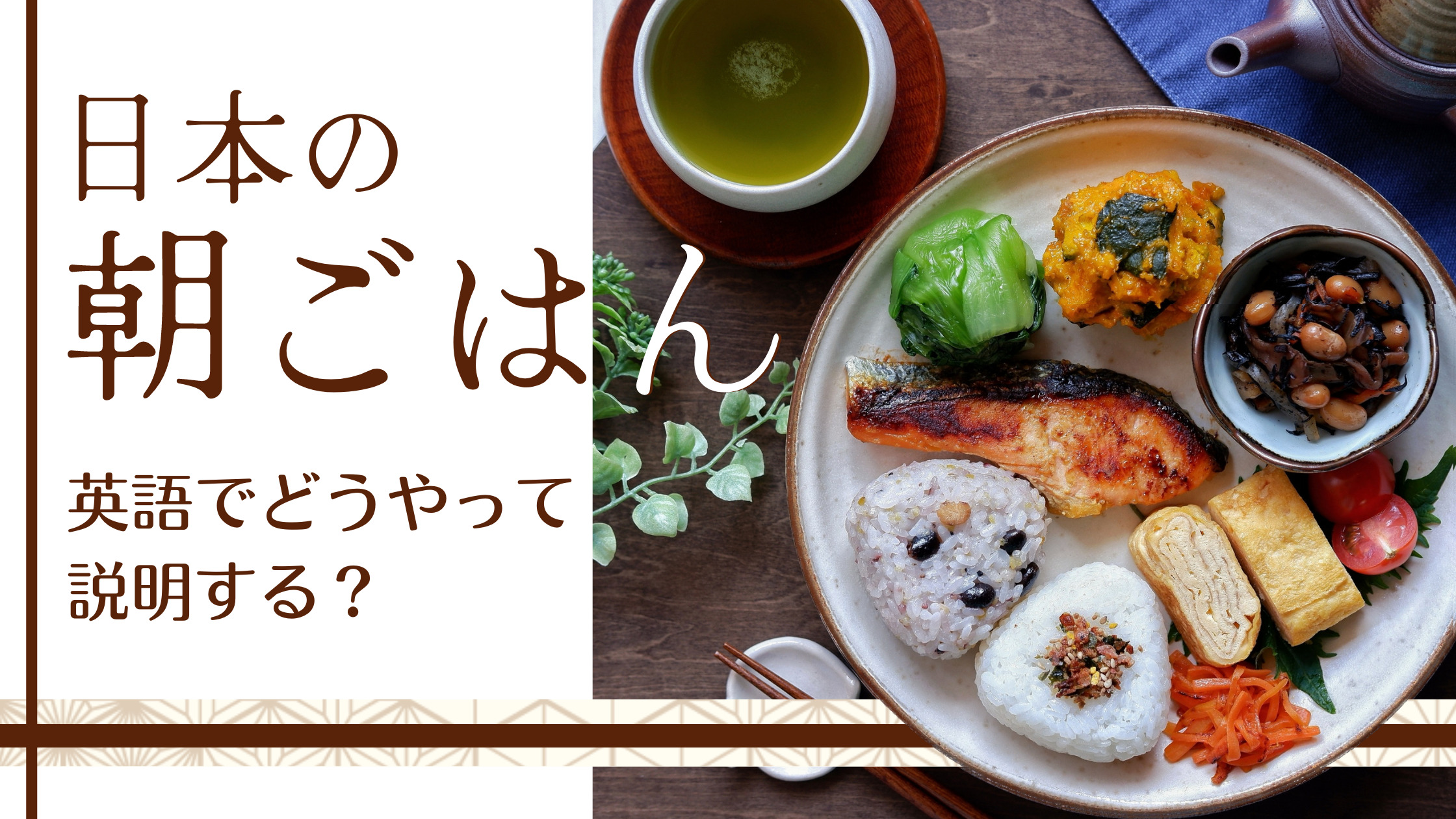朝食は1日元気よく過ごすためには欠かせないものです。日本の朝食は、ご飯、味噌汁、焼き魚、納豆などどれも健康的なものばかりです。
今回は、日本の朝ごはんについて英語で解説していきます。健康的な朝食メニューを英語で学べますので、ぜひ読み進めてください。
英語記事:


【この記事を書いているのは…】
石井 政章(いしい まさあき)
元ホテルマンです。リゾートホテル、シティホテルで主にフロントスタッフとして働いていました。
ホテルで働こうと思ったきっかけは、海外が好きで英語を活かしたいのと人を喜ばせたいという想いがあったからです。
現在は退職しWebライターとして活動しています。
英語で「朝ごはん」は何と言う?
英語で朝ご飯は、ご存知の通り「breakfast」(ブレックファスト)と言います。
夕ご飯から朝食までは時間が空きますね。そこで、「fast(絶食)」を「break(破る)」という意味で、「breakfast」という言葉が生まれたと言われています。
喫茶店などで使う「モーニング」は和製英語になり、朝食としての意味にはなりませんので注意してください。
英語で「日本の朝ごはん」を説明する
Traditional Japanese breakfast usually follows the style of a Japanese set meal, with the staple being rice and miso soup and ohitashi (boiled vegetables) served as side dishes.
日本の伝統的な朝食は通常、ご飯とみそ汁を主食とし、副菜としておひたしを添える和定食です。
Natto (fermented soybeans), pickles, and grilled fish are often also served on the side to help complement the rice.
納豆や漬物、焼き魚などもごはんのお供になることが多いです。
The harmonious pairing between carbohydrates, vegetables, and fermented foods is what makes the meal set well-balanced and nutritious.
日本の朝食は、炭水化物、野菜、発酵食品といったバランスのとれた栄養価の高いものになっています。
set meal 定食 / staple food 主食 / side dishes 副菜 / compliment 補完する / carbohydrate 炭水化物 / fermented foods 発酵食品 / nutritious 栄養価が高い

ごはん
Rice is an essential part of not just a traditional Japanese breakfast, but of food here in Japan as a whole.
日本の朝食だけでなく、日本の食卓に欠かせない米。
Rice is rich in carbohydrates and provides a charge of energy to run the body and brain all day long.
米は炭水化物が豊富で、体と脳を一日中動かすためのエネルギーを供給します。
Recently, health trends have given rise to the consumption of brown rice and five-grain rice as they contain many minerals and nutrients and have been said to be effective in suppressing increasing blood sugar levels.
最近では健康志向から、ミネラルや栄養素を多く含み、血糖値の上昇を抑える効果があると言われている玄米や五穀米の摂取が増えています。
essential 欠かせない / carbohydrate 炭水化物 / brown rice 玄米 / five-grain rice 五穀米 / blood sugar level 血糖値
味噌汁
Miso soup is another dish that is always present in a traditional Japanese breakfast.
味噌汁も、日本の伝統的な朝食に必ず登場する料理のひとつです。
Miso soup is made by boiling a number of raw ingredients in hot water and then dissolving the miso paste to make the broth.
味噌汁は、いくつかの具材を熱湯で煮て、味噌を溶かしてスープを作ります。
The typical ingredients for miso soup are tofu and wakame seaweed.
典型的な味噌汁の具材は、豆腐とわかめです。
Recipes vary by household but other common ingredients include deep-fried tofu, eggplant, and mushrooms.
レシピは家庭によって異なりますが、油揚げ、なす、きのこなどの具材もよく使われます。
dissolve 溶かす / broth スープ / household 家庭 / deep-fried tofu 油揚げ
納豆
Natto is another typical breakfast food in Japan and is made by fermenting soybeans.
納豆は日本の代表的な朝食で、大豆を発酵させて作られます。
Due to its sticky and stinky nature, not everyone is particularly fond of natto.
ネバネバして臭い性質があるため、誰もが納豆が好きというわけではありません。
However, since natto is made from soybeans, it is rich in protein and incredibly healthy.
納豆は大豆から作られているため、タンパク質が豊富で非常に健康的です。
ferment 発酵させる / nature 性質 / be fond of ~が好き
卵焼き
Tamagoyaki is made by repeatedly spreading a beaten egg solution in a hot square pan and then repeatedly rolling it up when it is lightly cooked.
卵焼きは、熱した四角い鍋に溶き卵液を流し込み、軽く火が通ったら巻き上げを繰り返すことで作られます。
The special square frying pan used to make tamagoyaki is called “tamagoyaki-ki” in Japanese, and is a cooking utensil that is widely found in most Japanese households.
卵焼きを作るための特別な四角いフライパンは、日本語で「卵焼き器」と呼ばれ、多くの日本の家庭に見られる調理器具です。
Mirin (sweet rice sake), soy sauce, sugar, and dashi (Japanese soup stock) are added to flavor the beaten egg solution, giving it a unique taste different than just regular eggs.
みりん、しょうゆ、砂糖、だしを加えて溶き卵液に味付けをすることで、普通の卵とは違う独特の味わいになっています。
While tamagoyaki is a popular breakfast dish, If you cut the baked tamagoyaki into pieces, it can be used as a suitable filling for your lunch box.
卵焼きは朝食の人気メニューですが、焼きあがった卵焼きをカットすれば、お弁当の具材としても使えます。
ferment 発酵させる / nature 性質 / be fond of ~が好き
焼き魚
Yakizakana is fish that has been grilled well.
焼魚はよく焼いた魚のことです。
There are many types of fish cooked for yakizakana, and common fish include mackerel, horse mackerel, saury, atka mackerel, and salmon.
焼き魚に使う魚は種類が多くあり、サバ、アジ、サンマ、ホッケ、サーモンなどです。
Cooking yakizakana is just sprinkling a good amount of salt on the open fish, whole fish, or a fish fillet and broiling it on the grill or charcoal grill until well browned.
焼き魚の作り方は、開いた魚、丸ごとの魚、または魚の切り身に適量の塩をふりかけ、グリルまたは炭火焼きグリルで十分に焦げ目がつくまで焼きます。
The freshly grilled fish is delicious and the salt enhances the flavor of the fish.
焼きたての魚は美味しく、塩が魚の味を引き立てます。
Grilled fish goes well with rice and is very tasty when eaten together.
焼き魚はご飯によく合い、一緒に食べるととても美味しいです。
grilled fish 焼き魚 / sprinkle ふりかける / enhance 高める
おひたし
Ohitashi is a Japanese vegetable dish made by dipping boiled vegetables in a seasoning solution of dashi stock and soy sauce (or dashi-tsuyu).
おひたしは、茹でた野菜をだし汁と醤油(または、だしつゆ)を合わせた調味液につけて作る日本の野菜料理です。
Spinach and komatsuna are the most common vegetables used for ohitashi.
おひたしに使う野菜は、ほうれん草と小松菜が一般的です。
They contain iron, which is said to be effective in preventing anemia.
貧血予防に効果があると言われている鉄分が含まれています。
If you add dried bonito flakes to ohitashi, the flavor increases and makes your ohitashi even more delicious.
おひたしに鰹節を加えると風味が増して、より一層おいしいおひたしになります。
solution 調味液 / dashi stock だし汁 / anemia 貧血 / dried bonito flakes 鰹節
お漬物
Otukemono is a dish of Japanese pickles made by fermenting various ingredients in a pickling liquid such as vinegar or salt for an extended period of time.
お漬物とは、さまざまな食材を酢や塩などのピクルス液で長時間発酵させた日本の漬物の料理です。
Most of the ingredients used for otsukemono pickles are vegetables such as cucumbers, turnips, Japanese radishes, and eggplants.
お漬物に使われる具材のほとんどは、きゅうり、かぶ、大根、なすなどの野菜です。
Since otsukemono has a strong flavor, it is an ideal accompaniment to rice and you will not be able to stop eating until you reach the bottom of the bowl.
おつけ物は味が濃いので、ご飯のお供に最適で、食べると止まらなくなります。
cucumber きゅうり / turnip かぶ / Japanese radish 大根 / eggplant なす / ideal accompaniment to rice 理想的なごはんのお供
まとめ
日本の朝ごはんは健康的なメニューばかりで、注目されている食事です。
「日本人は、朝ごはんに何を食べるの?」と質問されたら、ぜひ参考にしてください。
あわせて読みたい
英語を活かして外国人ゲストをおもてなし!

- 日本の魅力を外国人に紹介したい
- 英語や語学を活かした仕事がしたい
- 人を喜ばせることが好き
そんな方にぴったりな仕事が通訳案内士やツアーガイドのお仕事です。
通訳案内士(ツアーガイド)は、一緒に街を歩いて、地域の歴史や文化をお話しながら、外国人ゲスト一人一人の旅が素敵なものになるようお手伝いします。
ガイドの印象によって、日本の印象が決まると言っても過言ではありません。
人を楽しませることが好きで、日本の魅力を世界に伝えたい!という情熱をお持ちの方は、ツアーガイドを目指しませんか?

JapanWonderGuide(JWG)は「日本のガイドの質を世界一に」をスローガンに掲げるガイドコミュニティです。
2020年から活動を開始し、全国通訳案内士等を中心に、現在は、3,800名を超えるコミュニティとなっております。
JWGの有料会員(Knottist, ノッティスト)にご登録いただくと、月額1,000円(税込1,100円)で、
ガイディングやビジネスに活きる知識・スキルが身につく研修動画、E-Learningが見放題!有料コンテンツを無料でご視聴いただけます。
そのほか、人気観光施設の最新情報や裏話をお届けするJWG Live!の見逃し配信、各研修の割引などをご利用いただけます。
さらに、有料、無料会員ともに研修やイベント情報など、ガイドに役立つ内容がたっぷり詰まったメルマガを月に2回お届けします。
また、ガイド仲間を見つけ、交流できるFacebookグループにもご招待!情報交換の場としてお使いください。
【JWG会員でできること】
| Knottist Free | Knottist | Knottist+ | |
| 料金 | 無料 | 月額1,000円 (税込1,100円) | 年間14,000円※ (税込15,400円) |
| 期間 | 無期限 | 毎月自動更新 | 2026年8月31日まで |
| ①メンバー限定Facebookグループご招待 | ○ | ○ | ○ |
| ②メンバー向けメルマガ受信 | ○ | ○ | ○ |
| ③JWG Live!見逃し配信 | △ | ○ | ○ |
| ④JWG主催研修割引 | – | ○ | ○ |
| ⑤JWG交流会へご招待 | 有料 | 無料 | 無料 |
| ⑥通訳案内研修 | – (3,500円) | 無料 | 無料 |
| ⑦JWG動画配信 | 有料 | 無料 | 無料 |
| ⑧通訳ガイド保険 | – | – | ○ |
※Knottist+の会費は加入月によって変動します
JWGでは、ガイドのスキルアップを目指す方や、ガイドに挑戦したい新人ガイドさん、
ガイドに興味のある方を全力サポートいたします!
「学校の合間に」「週末だけ」
JapanWonderGuideと一緒に、「ツアーガイド」の世界の扉を開きませんか?






